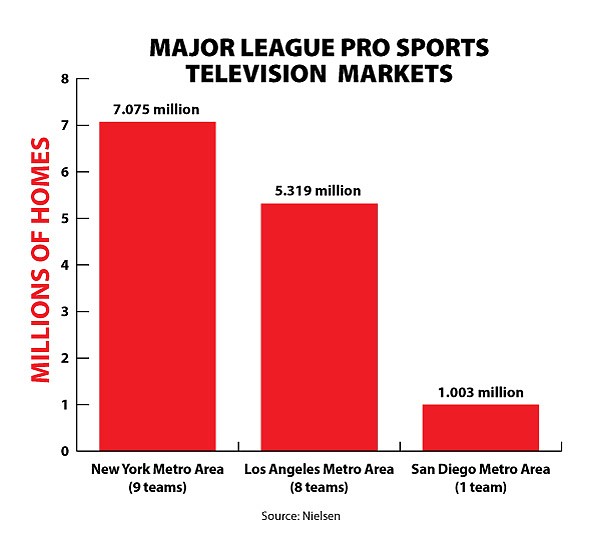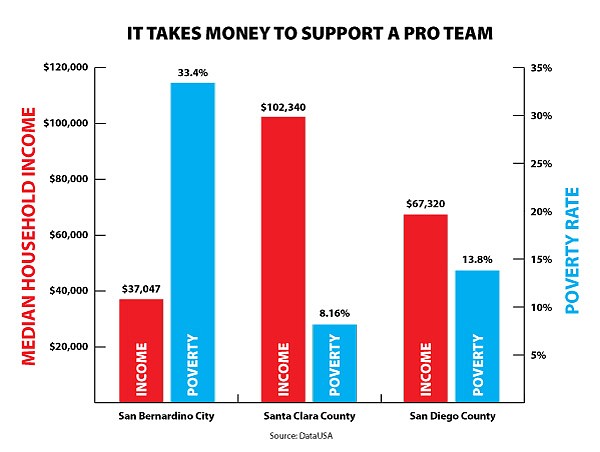 Facebook
Facebook
 X
X
 Instagram
Instagram
 TikTok
TikTok
 Youtube
Youtube

Once again, civic boosters are hoping San Diego will land another professional sports team. Big bucks are behind an attempt to rip down the former Qualcomm Stadium and make it home for a pro soccer team. Some folks want to rehab that stadium and pray that another NFL team will occupy it. Others want some form of professional basketball and/or hockey team.
There may not be political barriers to accomplish these goals (politicians love subsidies to billionaire sports-team owners), but there are economic and demographic barriers to getting a pro team.

Any municipal area hosting a team must be fairly large and, given the cost of tickets these days, at least moderately wealthy. And, critically, there can’t be too much competition from other forms of entertainment.
You can expect the jock lovers promoting new teams to haul out one starkly fallacious argument: that San Diego is the 8th-largest city in the United States. True. San Diego is the 8th-largest city, with a population of 1.4 million. The size of the city is meaningless. The size of the market is more important. San Diego County is the 17th-largest market with a population of 3.3 million.

With one exception, every one of the 30 most populous metro areas has at least one team in a major pro league (National Football League, National Basketball Association, Major League Baseball, and National Hockey League). Even New Orleans (46th largest), Salt Lake City (48th), and Buffalo (50th) have at least one team in a major league. (Buffalo and New Orleans have two.)
But which major market has no big-league pro teams? It’s Riverside–San Bernardino, the 13th-largest market with 4.5 million people. The city of San Bernardino has a pathetic median household income of $37,047 with a stunning poverty rate of 33.4 percent, according to information compiled by Data USA. The county has a median household income of $53,803 and a poverty rate of 19 percent — similar to Riverside County’s median household income of $58,292 and poverty rate of 16.2 percent. All told, that market could not support a major pro team, even though its population is a good deal larger than San Diego’s market.
By comparison, Santa Clara County, the heart of Silicon Valley, has a median household income of $102,340 and a poverty rate of only 8.16 percent. Its metro area is only the nation’s 35th-largest, with a population of just under 2 million. But you can see why the San Francisco 49ers play their games there: Silicon Valley is rolling in money. (However, Santa Clara County is only the 10th-richest county in the U.S., according to Forbes. “More wealth seems to reside in counties with a high concentration of government and government-subsidized industries,” says the magazine. Hmmm...)
San Diego County has a median household income of $67,320 and a poverty rate of 13.8 percent. Income is moderately above the national level, but the cost of living is consistently 30 to 40 percent higher than the national rate; ergo, a debilitating squeeze. The major problems are high housing, water, and electricity prices. In 2016, San Diego ranked a sorry 122 out of 150 American cities in median salary adjusted for cost of living, according to WalletHub, which puts together statistical data on cities, metro areas, and states. A 2014 study by the Center on Policy Initiatives and the Insight Center for Community Economic Development concluded that 38 percent of the county’s working-age households can’t afford a no-frills lifestyle without public or private assistance.
Not surprisingly, San Diegans have to go into debt to survive the squeeze. WalletHub did a study of credit-card debt among 2564 United States cities. Each is categorized in a percentile, with 99th percentile the worst, or debt that is the least sustainable. San Diego came in a disquieting 72nd percentile in median credit-card balance ($2853), 65th percentile in cost of interest until payoff ($218), and 53rd percentile in expected payoff time (11 months). The mortgage situation is worse: San Diego’s mortgage-debt-to-income ratio is in the 94th percentile. Overall, San Diego’s overleverage score is in the 83rd percentile — not good at all.
Bottom line: San Diego is only economically so-so, at best, among American metro areas.
While San Diego is the 17th-largest metro area, it is only the 28th-largest television market, according to stationindex.com. That makes a difference to most pro teams that might choose San Diego as a home.
Of course, the National Football League does things differently in doling out TV revenue. It’s split evenly among all teams, in large and small, rich or poor markets. In 2016, the National Football League split $7.8 billion in TV revenue evenly among its 32 teams. That came to $244 million per team, according to Bloomberg.
But will the league’s fat TV revenue last? This year’s Super Bowl television audience was down 7 percent from last year. Last year, the viewership of Sunday Night Football, Monday Night Football, and Thursday Night Football dropped 9 percent collectively. Monday Night Football had its lowest audience ever. This probably diminishes the chance of San Diego getting another pro football team anytime soon.
Major League Baseball is going swimmingly. According to Forbes, the average value of a team rose 19 percent from 2016 to 2017. The Padres were worth $1.1 billion beginning last season. That was 21st of 30 teams. The local team slashed its payroll last season and had a dismal 71–91 record, but home attendance averaged 26,401, and that was 18th of the 30 teams. TV ratings were 19th. The not-so-good news: WalletHub lists San Diego as among municipalities with the “least engaged Major League Baseball fans.” Still, considering everything, the Padres are doing better economically than might be expected — but these numbers probably won’t make the market enticing to investors in a pro football, basketball, hockey, or soccer team.
Why? Well, it’s that third factor I mentioned in the third paragraph — competition. According to WalletHub, San Diego is the nation’s 4th-best city for the active lifestyle. Cities were rated on their relative number of sporting-goods stores, basketball hoops, baseball and softball diamonds, swimming pools, public golf courses, fitness centers, hiking trails, bike-rental locations, and parkland acreage, along with weather and proximity to the ocean. Many of these activities cost little or nothing — most cost far less than a ticket to a sporting event. San Diego is known for its golf courses — and a round of golf costs much less now than it did a few years ago because of overbuilding in the 1990s.
The very thing that makes San Diego so enticing — the perfect weather — is a negative for pro sports teams.


Once again, civic boosters are hoping San Diego will land another professional sports team. Big bucks are behind an attempt to rip down the former Qualcomm Stadium and make it home for a pro soccer team. Some folks want to rehab that stadium and pray that another NFL team will occupy it. Others want some form of professional basketball and/or hockey team.
There may not be political barriers to accomplish these goals (politicians love subsidies to billionaire sports-team owners), but there are economic and demographic barriers to getting a pro team.

Any municipal area hosting a team must be fairly large and, given the cost of tickets these days, at least moderately wealthy. And, critically, there can’t be too much competition from other forms of entertainment.
You can expect the jock lovers promoting new teams to haul out one starkly fallacious argument: that San Diego is the 8th-largest city in the United States. True. San Diego is the 8th-largest city, with a population of 1.4 million. The size of the city is meaningless. The size of the market is more important. San Diego County is the 17th-largest market with a population of 3.3 million.

With one exception, every one of the 30 most populous metro areas has at least one team in a major pro league (National Football League, National Basketball Association, Major League Baseball, and National Hockey League). Even New Orleans (46th largest), Salt Lake City (48th), and Buffalo (50th) have at least one team in a major league. (Buffalo and New Orleans have two.)
But which major market has no big-league pro teams? It’s Riverside–San Bernardino, the 13th-largest market with 4.5 million people. The city of San Bernardino has a pathetic median household income of $37,047 with a stunning poverty rate of 33.4 percent, according to information compiled by Data USA. The county has a median household income of $53,803 and a poverty rate of 19 percent — similar to Riverside County’s median household income of $58,292 and poverty rate of 16.2 percent. All told, that market could not support a major pro team, even though its population is a good deal larger than San Diego’s market.
By comparison, Santa Clara County, the heart of Silicon Valley, has a median household income of $102,340 and a poverty rate of only 8.16 percent. Its metro area is only the nation’s 35th-largest, with a population of just under 2 million. But you can see why the San Francisco 49ers play their games there: Silicon Valley is rolling in money. (However, Santa Clara County is only the 10th-richest county in the U.S., according to Forbes. “More wealth seems to reside in counties with a high concentration of government and government-subsidized industries,” says the magazine. Hmmm...)
San Diego County has a median household income of $67,320 and a poverty rate of 13.8 percent. Income is moderately above the national level, but the cost of living is consistently 30 to 40 percent higher than the national rate; ergo, a debilitating squeeze. The major problems are high housing, water, and electricity prices. In 2016, San Diego ranked a sorry 122 out of 150 American cities in median salary adjusted for cost of living, according to WalletHub, which puts together statistical data on cities, metro areas, and states. A 2014 study by the Center on Policy Initiatives and the Insight Center for Community Economic Development concluded that 38 percent of the county’s working-age households can’t afford a no-frills lifestyle without public or private assistance.
Not surprisingly, San Diegans have to go into debt to survive the squeeze. WalletHub did a study of credit-card debt among 2564 United States cities. Each is categorized in a percentile, with 99th percentile the worst, or debt that is the least sustainable. San Diego came in a disquieting 72nd percentile in median credit-card balance ($2853), 65th percentile in cost of interest until payoff ($218), and 53rd percentile in expected payoff time (11 months). The mortgage situation is worse: San Diego’s mortgage-debt-to-income ratio is in the 94th percentile. Overall, San Diego’s overleverage score is in the 83rd percentile — not good at all.
Bottom line: San Diego is only economically so-so, at best, among American metro areas.
While San Diego is the 17th-largest metro area, it is only the 28th-largest television market, according to stationindex.com. That makes a difference to most pro teams that might choose San Diego as a home.
Of course, the National Football League does things differently in doling out TV revenue. It’s split evenly among all teams, in large and small, rich or poor markets. In 2016, the National Football League split $7.8 billion in TV revenue evenly among its 32 teams. That came to $244 million per team, according to Bloomberg.
But will the league’s fat TV revenue last? This year’s Super Bowl television audience was down 7 percent from last year. Last year, the viewership of Sunday Night Football, Monday Night Football, and Thursday Night Football dropped 9 percent collectively. Monday Night Football had its lowest audience ever. This probably diminishes the chance of San Diego getting another pro football team anytime soon.
Major League Baseball is going swimmingly. According to Forbes, the average value of a team rose 19 percent from 2016 to 2017. The Padres were worth $1.1 billion beginning last season. That was 21st of 30 teams. The local team slashed its payroll last season and had a dismal 71–91 record, but home attendance averaged 26,401, and that was 18th of the 30 teams. TV ratings were 19th. The not-so-good news: WalletHub lists San Diego as among municipalities with the “least engaged Major League Baseball fans.” Still, considering everything, the Padres are doing better economically than might be expected — but these numbers probably won’t make the market enticing to investors in a pro football, basketball, hockey, or soccer team.
Why? Well, it’s that third factor I mentioned in the third paragraph — competition. According to WalletHub, San Diego is the nation’s 4th-best city for the active lifestyle. Cities were rated on their relative number of sporting-goods stores, basketball hoops, baseball and softball diamonds, swimming pools, public golf courses, fitness centers, hiking trails, bike-rental locations, and parkland acreage, along with weather and proximity to the ocean. Many of these activities cost little or nothing — most cost far less than a ticket to a sporting event. San Diego is known for its golf courses — and a round of golf costs much less now than it did a few years ago because of overbuilding in the 1990s.
The very thing that makes San Diego so enticing — the perfect weather — is a negative for pro sports teams.
Comments